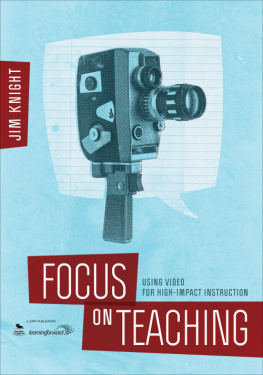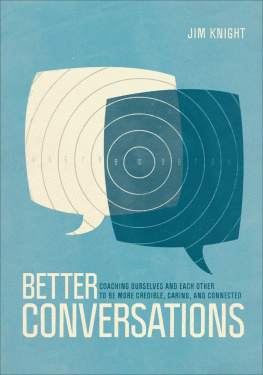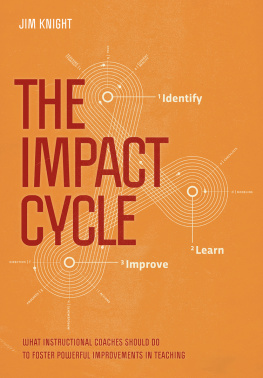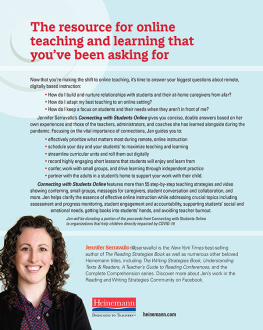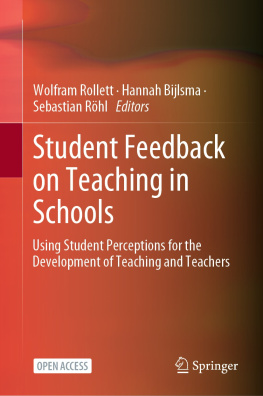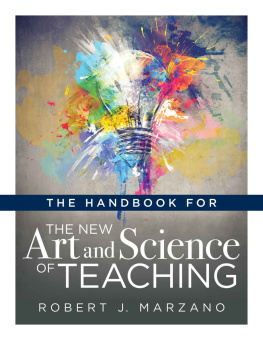

For my son Cameron Knight
A computer genius, but more importantly, an incredibly kind-hearted man. Im very proud to be your Dad, Cam.

Copyright 2014 by Corwin
All rights reserved. When forms and sample documents are included, their use is authorized only by educators, local school sites, and/or noncommercial or nonprofit entities that have purchased the book. Except for that usage, no part of this book may be reproduced or utilized in any form or by any means, electronic or mechanical, including photocopying, recording, or by any information storage and retrieval system, without permission in writing from the publisher.
All trade names and trademarks recited, referenced, or reflected herein are the property of their respective owners who retain all rights thereto.
Cover design by Clinton Carlson.
Printed in the United States of America
Library of Congress Cataloging-in-Publication Data
A catalog record of this book is available from the Library of Congress.
ISBN: 978-1-4833-4412-6
This book is printed on acid-free paper.
14 15 16 17 18 10 9 8 7 6 5 4 3 2 1

For information:
Corwin
A SAGE Company
2455 Teller Road
Thousand Oaks, California 91320
(800) 233-9936
www.corwin.com
SAGE Publications Ltd.
1 Olivers Yard
55 City Road
London EC1Y 1SP
United Kingdom
SAGE Publications India Pvt. Ltd.
B 1/I 1 Mohan Cooperative Industrial Area
Mathura Road, New Delhi 110 044
India
SAGE Publications Asia-Pacific Pte. Ltd.
3 Church Street
#10-04 Samsung Hub
Singapore 049483
Acquisitions Editor: Dan Alpert
Associate Editor: Kimberly Greenberg
Editorial Assistant: Cesar Reyes
Production Editor: Melanie Birdsall
Copy Editor: Kim Husband
Typesetter: C&M Digitals (P) Ltd.
Proofreader: Caryne Brown
Indexer: Sheila Bodell
Graphic Designer: Gail Buschman
LIST OF COMPANION WEBSITE RESOURCES
 | Access the following videos and resources at www.corwin.com/focusonteaching |
PREFACE
I learned about the power of video from my friend and colleague Mike Hock close to two decades ago when we were both doctoral students at the University of Kansas. Mike had created a successful tutoring program, Strategic Tutoring (Hock, Schumaker, & Deshler, 2001), and he spent a fair amount of time training tutors to tutor in a way that ensured students learned how to learn as they completed academic tasks.
In his work with tutors, Mike noticed that many were struggling to learn and fluently implement the specific stages and practices that made up strategic tutoring. He decided to video-record the tutors in action and then have them watch themselves tutoring and analyze their practices with the help of a checklist. The results were amazing! When tutors saw themselves on video, they quickly realized how they needed to improve, and their tutoring significantly improved.
I could see that video was a powerful learning tool for educators, but video was such a hassle at the time. We had to get camerasthey were usually expensiveset them up, tape a session, and then transfer the video to a VHS tape so we could watch it. Besides, the rather large camera on a tripod usually disrupted the class so that whenever we brought a camera into a teachers classroom, the class inevitably ended up being largely about the camera. In other words, even though video clearly worked, it took too much effort and caused too many distractions.
In 2006, I got a solution for the video hassle from an unlikely source: Mick Jagger. As I watched the televised coverage of the World Cup that year, I noticed that Mick was shown several times recording the events with a flashy little camera, which I learned was a Flip cameraa tiny, easy-to-use, inexpensive HD camera. Watching Mick film parts of the game, I figured that I could use a Flip camera to record a class without disrupting the teachers lesson. So I decidedto try out Flip cameras as a part of our research at the University ofKansas.
I first introduced cameras to our team of instructional coaches working on our research projects in Topeka, Kansas. We quickly realized that video was a game breaker. Professional learning would never be the same again! As time has passed, technological innovation has made it easier and easier to video-record and share a lesson, and in all likelihood video will become even easier and more powerful as technology advances in the future.
This book summarizes the findings of a number of projects that directly or indirectly studied video and coaching. As mentioned, first, our research team at the Kansas Coaching Project at the University of Kansas and instructional coaches in Topeka, Kansas, explored how video might be integrated into the coaching process. Then our team and instructional coaches from Beaverton, Oregon, employed a design research model (Bradley et al., 2013) to refine how coaches could use video with teachers to gather data on current realities in a classroom, set goals, and monitor progress toward the goals. Our team is now in the midst of a second design study with coaches in Othello, Washington, who are also helping us refine how to use video within the components of coaching.
In addition to these studies, I conducted a study of how to use video or audio recordings to improve communication skills. As part of the research, I received more than 500 reflection reports from people working on their communication skills in countries around the world, including India, Australia, South Korea, the United Kingdom, Canada, and the United States. The volunteer participants in this project, sponsored by the Instructional Coaching Group, wrote about how they used recordings to improve how they listened, built emotional connections, and found common ground during their interactions with others.
Finally, Marilyn Ruggles, my colleague at the Instructional Coaching Group, and I conducted about 50 interviews with teachers, coaches, and principals in U.S. schools about their experiences with video-enhanced professional development. The names and positions of the interviewees, who generously agreed to be interviewed twice, are included in the Acknowledgments.
In writing this book, I have drawn heavily from my interviews and included the comments of teachers, instructional coaches, and principals. All interview comments are taken from transcripts of interviews. In some cases, I have modified comments slightly to increase clarity (e.g., replacing pronouns with antecedents, for example) or made them more concise (e.g., putting two comments together). However, I have been careful to keep the content of each participants comments intact.
Video changes everything. That is the big message I heard in all of our interviews. But those changes can be helpful or damaging. Used poorly in a compulsory, heavy-handed way, video recording can damage teacher morale at a time when, for many teachers, morale is at an all-time low. Used effectively, in a way that honors teachers professionalism and learning, video can be the most powerful improvement we have experienced in our schools in a long time. My sincere hope is that this book will enable us to use video effectively in a way that will help us provide the best possible learning opportunities for all of our students.
Next page
